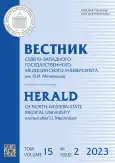Прогностическое значение изменений коронарного кровотока у пациентов с сохраненной фракцией выброса
- Авторы: Калинина Е.С.1,2, Загатина А.В.1, Сайганов С.А.2
-
Учреждения:
- Санкт-Петербургский научно-исследовательский кардиологический центр «Медика»
- Северо-Западный государственный медицинский университет им. И.И. Мечникова
- Выпуск: Том 15, № 2 (2023)
- Страницы: 79-86
- Раздел: Оригинальные исследования
- URL: https://journals.rcsi.science/vszgmu/article/view/131107
- DOI: https://doi.org/10.17816/mechnikov321811
- ID: 131107
Цитировать
Аннотация
Обоснование. Измерение фракции выброса при эхокардиографическом исследовании позволяет оценить глобальную сократимость левого желудочка. Снижение данного показателя свидетельствует о неблагоприятном прогнозе у пациентов, а в диапазоне нормальных значений этот параметр теряет свою прогностическую значимость. Для пациентов с нормальной фракцией выброса необходима разработка других прогностических методов.
Цель исследования — изучить влияние изменений параметров коронарного кровотока, измеренных при помощи допплерографического исследования, у пациентов с сохраненной фракцией выброса левого желудочка в прогнозировании неблагоприятных исходов в течение года.
Материалы и методы. В проспективное исследование включали пациентов, направленных на эхокардиографию в 2019–2020 гг. и наблюдавшихся в Санкт-Петербургском научно-исследовательском кардиологическом центре «Медика». Критерием включения был возраст старше 18 лет, критерием исключения — снижение фракции выброса левого желудочка менее 53 %. Помимо стандартной эхокардиографии использовали допплерографию для исследования скоростных показателей кровотока в коронарных артериях. Срок наблюдения составил 1 год. В исследуемую подгруппу пациентов вошли 453 человека.
Результаты. За год наблюдения произошло 89 случаев спонтанных неблагоприятных событий, таких как смерть, инфаркт миокарда, нарастающая сердечная недостаточность, в том числе 19 летальных исходов. Умершие пациенты были старше выживших (средний возраст составил 76,6 ± 8,6 против 59,3 ± 15,5 лет; р < 0,000001), обладали меньшей глобальной продольной функцией (−13,8 ± 4,3 против −18,3 ± 3,6 %; р < 0,000001), большим индексом объема левого предсердия (54,6 ± 15,5 против 36,5 ± 13,1 мл/м2; р < 0,000000), большим давлением в легочной артерии (39,5 ± 14,7 против 29,5 ± 8,1 мм рт. ст.; р < 0,000000), большим индексом массы миокарда левого желудочка (108,7 ± 37,2 против 88,1 ± 24,1 г/м2, р < 0,000000) и нарушением диастолической функции [отношением скорости кровотока через митральный клапан в первую (раннюю) фазу наполнения левого желудочка и усредненной скорости движения фиброзного кольца митрального клапана 13,6 ± 7,1 против 9,4 ± 4,4; р < 0,000000], а также достоверно большей скоростью кровотока в передней межжелудочковой артерии (78,0 ± 39,0 против 50,0 ± 25,4 см/c; р < 0,000007). Только возраст и скорость кровотока в передней межжелудочковой артерии были независимыми предикторами смерти и инфаркта миокарда (р < 0,004).
Заключение. Скоростные показатели кровотока в передней межжелудочковой артерии являются значимым прогностическим параметром краткосрочных спонтанных событий, включая смерть, у пациентов с сохраненной фракцией выброса.
Полный текст
Открыть статью на сайте журналаОб авторах
Елена Сергеевна Калинина
Санкт-Петербургский научно-исследовательский кардиологический центр «Медика»; Северо-Западный государственный медицинский университет им. И.И. Мечникова
Автор, ответственный за переписку.
Email: lennohka@mail.ru
ORCID iD: 0000-0002-4007-3322
SPIN-код: 1022-1800
Scopus Author ID: 57202388238
врач-кардиолог, врач функциональной диагностики
Россия, Санкт-Петербург; Санкт-ПетербургАнжела Валентиновна Загатина
Санкт-Петербургский научно-исследовательский кардиологический центр «Медика»
Email: zag_angel@yahoo.com
ORCID iD: 0000-0002-9085-4872
SPIN-код: 2734-1620
Scopus Author ID: 22939399700
д-р мед. наук
Россия, Санкт-ПетербургСергей Анатольевич Сайганов
Северо-Западный государственный медицинский университет им. И.И. Мечникова
Email: ssayganov@gmail.com
ORCID iD: 0000-0001-8325-1937
SPIN-код: 2174-6400
д-р мед. наук, профессор
Россия, Санкт-ПетербургСписок литературы
- Marwick T.H. Ejection Fraction Pros and Cons: JACC State-of-the-Art Review // J. Am. Coll. Cardiol. 2018. Vol. 72, No. 19. P. 2360–2379. doi: 10.1016/j.jacc.2018.08.2162
- Rigo F., Caprioglio F. Transtenotic coronary flow velocity assessment: a new road map for non-invasive coronary evaluation? // Eur. Heart J. Cardiovasc. Imaging. 2015. Vol. 16, No. 12. P. 1318–1319. doi: 10.1093/ehjci/jev182
- Бощенко А.А., Врублевский А.В., Карпов Р.С. Трансторакальное ультразвуковое исследование магистральных коронарных артерий. Томск: STT, 2015. 240 с.
- Бощенко А.А., Врублевский А.В., Карпов Р.С. Диагностика стенозов ствола левой коронарной артерии и передней нисходящей коронарной артерии с помощью трансторакальной эхокардиографии // Комплексные проблемы сердечно-сосудистых заболеваний. 2016. № 2. С. 20–29. doi: 10.17802/2306-1278-2016-2-20-29
- Lang R.M., Badano L.P., Mor-Avi V. et al. Recommendations for cardiac chamber quantification by echocardiography in adults: an update from the American Society of Echocardiography and the European Association of Cardiovascular Imaging // J. Am. Soc. Echocardiogr. 2015. Vol. 28, No. 1. P. 1–39.e14. doi: 10.1016/j.echo.2014.10.003
- Zagatina A., Guseva O., Kalinina E. et al. Additive prognostic value of high baseline coronary flow velocity to ejection fraction during resting echocardiography: 3-year prospective study // Acta Cardiol. 2022. P. 1–11. doi: 10.1080/00015385.2021.2013004
- Morofuji T., Saito M., Inaba S. et al. Prognostic value of proximal left coronary artery flow velocity detected by transthoracic doppler echocardiography // Int. J. Cardiol. Heart Vasc. 2018. Vol. 19. P. 52–57. doi: 10.1016/j.ijcha.2018.04.003
Дополнительные файлы













